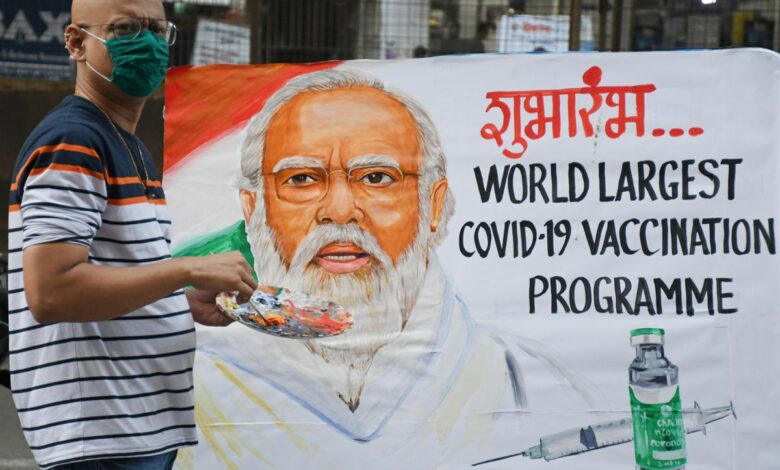The 1,500-mile travel itinerary of a coronavirus vaccine to reach every part of India

India is fighting the world’s fastest-growing outbreak of diseases while also implementing one of the most logistically complex vaccination campaigns. New Delhi has set a goal of vaccinating 300 million of the country’s 1.3 billion people by fall. Until being pumped into people living in rural, isolated towns, some of those doses will be transported hundreds of miles—by bus, plane, scooter, cruise, and even on foot. Each dosage must be monitored and held cold along the way. The problem has become even more serious as the number of infections has risen dramatically in recent weeks. The following is the account of one dose’s 1,500-mile path.
In India, the AstraZeneca vaccine was not approved for use until January 2nd. For another week, the dosage waited on the shelves before being divided into an ice-pack-lined plastic foam package holding about 1,000 vials and loaded into an enclosed vehicle. From there, it was a 30-minute drive to the Pune airport, where millions of doses were en route to various parts of the country. On January 13, it was loaded into the cargo hold of India’s largest airline, IndiGo, which has partnered with the government to help distribute vaccines around the world. It was moved to a different passenger flight run by the government airline Air India in Kolkata. The dose was among the first in the country, arriving in Pune a few days before India’s national vaccination campaign began on January 16th. The campaign became more urgent as the coronavirus rose in India, with more than 300,000 new cases a day last week. More than 2.5 million doses a day are now delivered regularly by India. Most of India’s vaccines are distributed through regional distribution centres as part of the country’s hub-and-spoke scheme.
Though India trails China and the United States in terms of shots delivered, it has set a higher goal—and in a world where a large majority of the population lives in poverty or in rural areas, this is a significant achievement. It’s about reaching out to the whole country. No one can be left behind if we want to put an end to the pandemic, not merely keep it underhand.
KOLKATA: Covid-19 vaccine supplies for the state are handled by the warehouse at the Central Family Welfare Stores in Kolkata, which has been handling India’s daily child vaccines for years. Staff set up shipments across West Bengal on a recent Saturday, attempting to make room for the increasing number of vaccines arriving each week. India has now administered over 140 million vaccines and expects to vaccinate over 300 million people by the end of the year.
PUNE: A half-millilitre dose of a vaccine produced by AstraZeneca and the University of Oxford began its life in a 1,500-liter metal tank here, months before it is accepted for use, among millions of others. The tank, which is one of the bioreactors used to develop the cells for vaccine production, will generate millions of doses at once. The Serum Institute of India, the world’s biggest vaccine producer, relies on bioreactors to get the job done. As soon as it received the recipe and tiny seed vial of material used to develop the vaccine from AstraZeneca in May, the Institute began producing and stockpiling doses. The dose is then transferred from the bioreactor to a 10-dose vial, which is then sealed with a stopper and stacked with millions of others on the warehouse’s giant purple-and-white racks, which were stored at about 40 degrees Fahrenheit. The dose would then travel 1,500 miles to a rural village in the country’s northeast following weeks in storage before being inserted into the shoulder of a schoolteacher 120 days after emerging from the bioreactor—another minor win in one of the world’s most ambitious yet logistically daunting vaccine programs.
AIZAWL: Aizawl is the capital of Mizoram, a northeastern state wedged between Myanmar and Bangladesh. For decades, its inhabitants have sought refuge on the slopes. The capital’s sweeping ridges are now teeming with towers, like a mini-Hong Kong in the middle of a jungle. There is no flat ground anywhere—even pigs are housed on hill-hugging bamboo platforms supported by stilts. Many of Mizoram’s nearly 1.5 million residents live in remote villages that are difficult to enter. Travelling less than 100 miles in a straight line will take up to ten hours, sometimes on short gravel roads that snake through mountains. The state is rushing to have shots before the monsoon begins in June, making roads impassable. “We need to finish as far as we can before the monsoon,” said Eric Zomawai, deputy director of the state’s health department. We get landslides and have to deal with them despite everything. Every dosage that arrives in Aizawl is quickly packed into a smaller plastic foam cooler with fresh ice packs and a credit-card-sized temperature console to ensure it stayed between 35 and 45 degrees for the next leg of the journey—an eight-hour trip to the rural district headquarters of Lunglei. There, the dosage had to wait for another long time for the delivery system to catch up with the supply. There were technological issues with the app-based system used to select, alert, and register citizens for vaccinations during the early stages of the vaccine campaign.
A similar itinerary is prepared for every single vaccine dosage produced or imported in the country to reach every single nook and corner of the vast Indian subcontinent. The vaccine shot that is being made accessible in our nearest inoculation centre is an outcome of the combined effort of hundreds of thousands of people working on the backend.





